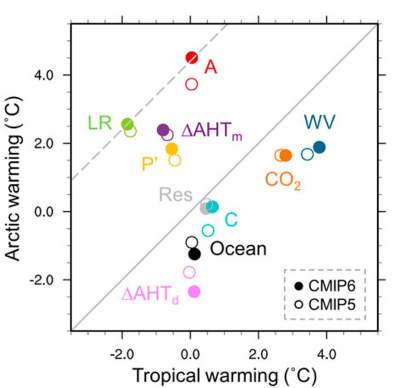Causes of Polar Amplification in Earth System Models
Greenhouse warming is enhanced in the Arctic relative to the rest of the globe, but models substantially disagree on the strength of this so-called polar amplification. Scientists at the University of Washington and Lawrence Livermore National Laboratory have applied advanced diagnostic techniques to quantify the individual contributions to polar amplification from specific radiative feedbacks, changes in atmospheric poleward heat transport, and changes in ocean heat storage across CMIP5 and CMIP6 models.
This study elucidates the wide variety of processes driving Arctic amplification across a large suite of Earth System Models, how they are changing with model generation, and which ones are important for causing inter-model differences. The two dominant contributors to Arctic-amplified warming (and its inter-model spread) are the locally positive surface albedo and lapse rate feedbacks, which are closely linked because decreasing snow and sea ice leads to warming that remains trapped near the surface owing to the Arctic atmosphere’s strong stability. Increased Arctic warming in CMIP6 versus CMIP5 arises from stronger albedo feedback, combined with a less-negative cloud feedback. Several key uncertainties needing future study are highlighted.
As a step towards understanding the fundamental drivers of polar climate change, we evaluate contributions to polar warming and its seasonal and hemispheric asymmetries in Coupled Model Intercomparison Project phase 6 (CMIP6) as compared with CMIP5. CMIP6 models broadly capture the observed pattern of surface- and winter-dominated Arctic warming that has outpaced both tropical and Antarctic warming in recent decades. For both CMIP5 and CMIP6, CO2 quadrupling experiments reveal that the lapse rate and surface albedo feedbacks contribute most to stronger warming in the Arctic than the tropics or Antarctic. The relative strength of the polar surface albedo feedback in comparison to the lapse-rate feedback is sensitive to the choice of radiative kernel, and the albedo feedback contributes most to inter-model spread in polar warming at both poles. By separately calculating moist and dry atmospheric heat transport, we show that increased poleward moisture transport is another important driver of Arctic amplification and the largest contributor to projected Antarctic warming. Seasonal ocean heat storage and winter-amplified temperature feedbacks contribute most to the winter peak in warming in the Arctic and a weaker winter peak in the Antarctic. In comparison with CMIP5, stronger polar warming in CMIP6 results from a larger surface albedo feedback at both poles, combined with less-negative cloud feedbacks in the Arctic and increased poleward moisture transport in the Antarctic. However, normalizing by the global-mean surface warming yields a similar degree of Arctic amplification and only slightly increased Antarctic amplification in CMIP6 compared to CMIP5.

